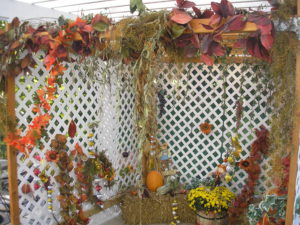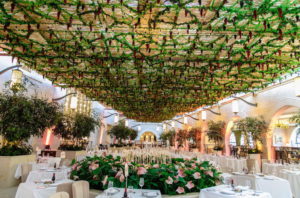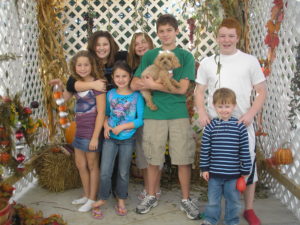Sukkot Celebrates Fall Harvest…And Much More
Now that Yom Kippur is over and the hard work is done, it’s time to get ready for the next Jewish holiday, Sukkot (Hebrew word for booths or huts),  a week-long harvest festival that begins Sunday night, five days after Yom Kippur.
The festival of Sukkot is one of the three great pilgrimage festivals—the others are Passover (April 8-16) and Shavuot (May 28-30). These holidays celebrate both agricultural festivals and historical events in the history of the Jewish people, when in ancient times Jewish people traveled to the Temple in Jerusalem. In Israel, Sukkot is a major holiday, no work, no school, and everyone is outdoors sharing meals, singing songs, and giving thanks for the bounty of another season.
Also known as the Feast of Tabernacles, Sukkot is like the American holiday Thanksgiving in that we give thanks for another season of crops that will sustain us, but it is so much more. Sukkot ranks right up there in important holidays because it commemorates the time when we received the Torah at Mount Sinai, were freed from slavery, and wandered the desert for 40 years to the Promised Land. Jews today are still on a journey, and holidays like Sukkot remind us to free ourselves from the material things that often keep us in bondage. It’s a time to detach from the comforts we are accostomed to inside our houses and reconnect with the natural wonders that sustain us inside a flimsly little hut called a sukkah (singular word for Sukkot).
Building a sukkah is a favorite tradition on this holiday, in fact, it’s a mitzvah to build a temporary outdoor structure to symbolize the temporary shelters that our ancestors lived in during their journey in the desert. During the weeklong festival of Sukkot, we are supposed to spend as much time in our sukkah as possible, even sleeping under the stars, and detaching from the comforts of our homes and gaining a new appreciation of nature. In Israel, land is scare so many families assemble their sukkah wherever they can, a nearby parking lot or balcony on their high rise apartment building. But not every sukkah in Israel is primitive–many luxury hotels in the Holy Land attract guests with with extravagent tents, linen draped tables, chandeliers, lush greenery, and of course, gourmet kosher meals with locally harvested delicacies.
The sukkah is the central theme of Sukkot and is made many different ways as long as it has a roof and three sides. The roof is usually made with tree branches, twigs, bamboo sticks, willow branches, pine tree pieces, palm leaves, whatever you collect in your yard. The idea is to provide some shade and protection from the sun and yet allow the stars to peek through at night. The walls can be made of cloth, burlap, wood, even bedsheets, whatever your imagination comes up with, while the inside of the sukkah is decorated with gourds, vines, colorful paper chains, artwork of Jewish themes, and drawings made by young artists in the family.
A typical sukkah is not meant to sustain storms and harsh conditions, reminding us that life is fragile and that Mother Nature or God is in control. In fact, on Sukkot, a central theme in the holiday prayers is rain. The farmers thank God for this year’s harvest and pray for rain for the coming year.
Sukkot is a joyful holiday and is referred to as zeman simchateynu, the “season of our joy.â€Another tradition is to invite ushpizin, a guest, to share a meal with us in our makeshift huts. In commemoration of the bounty of the Holy Land, we perform a special mitzvah that kids and adults really enjoy, We recite blessings over the Four Kinds: a citron, a palm branch, three myrtle twigs and two willow branches. The citron is held in one hand, while the palm, myrtle and willow are bundled together into what is called a lulav. An Etrog, a yellow citrus fruit that smells divine, is a kind of citron. The Four Species represent four different types of Jews–we gather them, bind them, and wave them all together as one united. One nation–united.
We say a prayer and shake the lulav and etrog in six directions to give thanks and remind us that God is found everywhere. We face each of the six directions – east, south, west, north, above and below  and wave them up and down.
The blessing is: Baruch atah Adonai Eloheynu Melech Ha Holam, asher kidshanu b’mitzvotav, v’tzivanu al netilat lulav. Blessed are You, Ruler of the Universe, Who has sanctified us with Your commandments and commanded us concerning the taking of the palm branch.
On the first day only, we recite a blessing called the Shechiyanu: Baruch atah Adonai, Eloheynu Melech Ha Olam, shechiyanu v’kimanu, v’higianu, lazman ha ze. Blessed are You Adonai our God, Ruler of the Universe, who has given us life, sustained us, and enabled us to reach this moment.
You can purchase an Israeli Etrog and lulav from local temples, Jewish schools, and even Amazon.
And like all Jewish holidays, food is another centerpiece. On Sukkot, we traditionally we eat vegetables and fruits of the harvest season, including foods from different grains including rye, spelt, barley, wheat and oat. We also stuff ourselves with stuffed foods, to symbolize food that is covered like the temporary sukkah,  and those delicacies can include stuffed cabbage, zucchini, squash, eggplant and tomato, plus kreplach, a tasty stuffed dumplings made out of rolled pasta dough and filled with ground beef or chicken, and for sweets rugalah and strudel. For more Sukkot recipes, go HERE.
Chag Sameach—Happy Holiday! And Shabbat Shalom!





